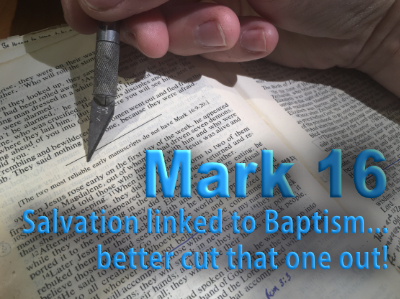
I love the Gospel of Mark. It is penned by John Mark who was the cousin of Barnabas and a sometimes traveling companion of the Apostle Paul. Historians speculate that John Mark was probably more associated with Peter than Paul and as a young man, would have been very close to him back in Jerusalem. For this reason, most of the information in the Gospel of Mark is probably gleaned from the stories Peter told.
Three Important Claims
As Mark’s Gospel closes out in chapter 16, there are some statements made which two different religious movements claim as important proof texts for their doctrines. The Charismatic Movement points to the disciples being told they will be able to do miracles and the pro-baptism groups point to Jesus comments about baptism.
Both groups bump into a road block when they turn to these scriptures because scholars do not believe this portion of Mark was ever in the original texts. They believe it was added later. Using this claim, their detractors dismiss any doctrinal conclusions which may spring from this neighborhood by diminishing the validity of this section of scripture. Take a look at your Bible and notice that Mark 16:9-20 has a seemingly ominous warning… “The two most reliable early manuscripts do not contain Mark 16:9-20.”
If we are having a discussion about the miraculous gifts of the Spirit or water baptism and someone wants question the authenticity of this passage of scripture, there is really no point in using it in the debate. In fact, it is probably better to just drop it and move on. So, that’s what we are going to do here at A Faith that Obeys. Let’s not add this particular scripture to our growing collection of scriptures which demonstrate the Biblical requirement of baptism for the forgiveness of sins, the gift of the Holy Spirit and the gift of e ternal life.
We will not use it!
But, you really should at least be familiar with the arguments… so let’s dive in.
Mark 16:14-20
“Later Jesus appeared to the Eleven as they were eating; he rebuked them for their lack of faith and their stubborn refusal to believe those who had seen him after he had risen.
He said to them, “Go into all the world and preach the good news to all creation. Whoever believes and is baptized will be saved, but whoever does not believe will be condemned. And these signs will accompany those who believe: In my name they will drive out demons; they will speak in new tongues; they will pick up snakes with their hands; and when they drink deadly poison, it will not hurt them at all; they will place their hands on sick people, and they will get well.”After the Lord Jesus had spoken to them, he was taken up into heaven and he sat at the right hand of God. Then the disciples went out and preached everywhere, and the Lord worked with them and confirmed his word by the signs that accompanied it.”
Getting the Context
As always, let’s make sure we are getting things in proper context. Who is Jesus talking to? The eleven disciples, exclusively. He is not talking to you and me at this point in time. He is speaking only to the Apostles. What is he doing? This seems familiar! He is presenting The Great Commission!
This passage of scripture is a retelling of Jesus’ final commands to the Apostles which would place this event just 10 days before Peter’s Pentecost sermon. It is super important to understand exactly what this event is, namely, a parallel presentation of The Great Commission. If we have any questions about it in Mark, we may get a more complete picture from the same account in Matthew, right?
In verse 15, Jesus tells the Apostles, “Go into all the world and preach the good news to all creation.” Yep! This is very familiar. Let’s compare it to the same passage in Matthew.
Matthew 28:19-20
“Therefore go and make disciples of all nations, baptizing them in the name of the Father and of the Son and of the Holy Spirit, and teaching them to obey everything I have commanded you.”
I think we can agree, we have a more complete understanding of all the Great Commission holds when we look at it in Matthew. This is where we see four crisp, clear, commands. Go. Make Disciples. Baptize them. Teach them to obey. There is a process and it’s easy to see. The Apostles must not stay where they are, they are to leave Jerusalem and ultimately preach the Good News to the entire world. They are to “make disciples.” How is that done? By the Apostles’ preaching, teaching, training and educating. It is done through verbal communication.
The process of making disciples
Making a disciple is a process. Once the message is received, we decide whether or not we are going to accept it. We evaluate what we hear and decide whether it is true and reasonable. In this process, belief and acceptance always come before obedience. It would be worthless to obey something the Apostles were teaching if you did not believe it or were unwilling to commit to for the rest of your life… in the case of The Great Commission. Why would anybody be baptized if they did not accept the message. That would be silly.
Finally, the people who become Christians are charged with obeying everything they have been taught by the person who introduced them to Christ, and by extension passing on the same teaching.
If Mark 16 is a parallel passage to Matthew 28, then all of the truths about the Great Commission from Matthew 28 have to be true about Mark 16. It’s the same thing!
Now, in Mark 16, after Jesus says, “Go into all the world and preach the good news to all creation,” we get a more detailed description of the doctrine. Jesus next says, “Whoever believes and is baptized will be saved, but whoever does not believe will be condemned.”
Salvation and Baptism Linked
This is the statement which makes Mark 16 valuable to the pro-baptism proponents. This statement links baptism to salvation. Salvation follows belief and baptism. Notice, the statement is presented as a conditional. Back in our Matthew account, there is no mention of salvation and there is no conditionals presented. But, here in Mark, these two things become part of the big picture.
As students of the Bible, let’s not throw something out because we don’t understand it. Let’s see if we can harmonize things. When we do that, we see the composite picture. Let’s combine these two accounts of the Great Commission! Allow me to paraphrase.
“Go, make disciples of all nations, baptizing them in the name of the Father, the Son and the Holy Spirit,. Teach them to obey everything I have commanded you. Those who believe your message and obey it, will be saved. Those who are unwilling to accept your message will be condemned.”
When we harmonize these two passages, we see the unfolding nature of the Biblical Plan of Salvation. Hearing the word and accepting the word always precede obedience to the word. That’s exactly what the passage in Mark says.
Some folks isolate the last statement Jesus makes, “whoever does not believe will be condemned” and claim that because Jesus does not mention baptism again in this part of the sentence; baptism must be excluded from the formula. This reasoning fails to take in our entire harmonized picture. The Great Commission includes baptism. Listen to the statement they would prefer to hear Jesus make:
“Whoever believes and is baptized will be saved, but whoever does not believe and is not baptized will be condemned.”
That’s a bit wordy! Baptism is a response to our belief, it makes no sense to be baptized if one does not have belief. There is no need to restate everything. If someone does not believe and accept the message, they would never be baptized. Isn’t that obvious? Think about the 3000 on the day of Pentecost. Only those who accepted the message were baptized. This is huge! If we have not been baptized, we have not accepted the message!
Now don’t miss that fact that the result is the same whether baptism is involved or not! If a person will not believe, they will be condemned. If a person is not baptized, their fate is the same because they never accepted the message. Mark 16 explains this perfectly.
Mark 16 echos The Great Commission, giving us a bit more about the interplay of baptism and salvation. I think it is a very helpful passage and clears things up, especially when we are willing to harmonize it with Matthew 28.
Context is King
When we present this passage as a proof text for whatever reason, it is super important to put it into the clear context of time, the clear context of who is speaking and the clear context of who is being spoken to. Jesus is speaking to the Apostles and the Apostles only. He is giving them a set of instructions we call, “The Great Commission.” He even tells them, as he did on earlier missions; they would have the power to do miraculous signs and wonders. That was nothing new.
It is also important to put this into chronological perspective. As Mark closed out, did you notice, that everything we read is written in the past tense? He closes his Gospel by confirming that the disciples went out, just as they were told to do. They preached everywhere. The Lord worked with them and confirmed his word by the signs that accompanied it. All of these are in the past tense. Mark paints a historical description of what happened after the birth of the Church. Mark gives us a really wonderful picture of what it was like as the Church era began.
Is this last section of the book of Mark an addition to the Gospel? You know, is it just some well meaning scribe’ s attempt to close out an otherwise abruptly ending Gospel with a bit of clarification? I don’t know. What I do know is that the things I find in this section of Mark do not change my theology at all. I see nothing inconsistent with my understanding of the Gospel or the Biblical Plan of Salvation. If anything, this brief section of the book of Mark emboldens me to always pursue A Faith that Obeys.
Enjoy!Dana Haynes
